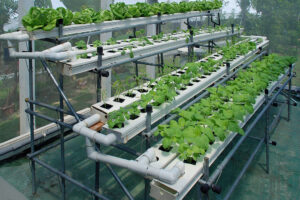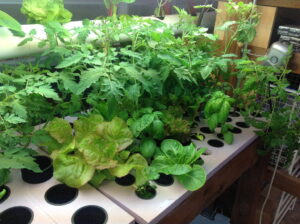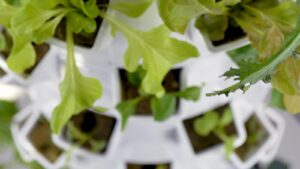Growing hydroponic crops can be a fascinating endeavor that promises bountiful yields for every green-thumb enthusiast. From the elegant beauty of lush, leafy greens to the vibrant explosion of tomatoes, the world of hydroponics opens a gateway to a new realm of agricultural possibilities. However, navigating the intricate maze of optimizing hydroponic crop nutrition can sometimes feel like unlocking nature’s best-kept secrets. That’s why in this article, we delve into the depths of plant nourishment, uncovering the best practices that will propel your hydroponic crops to unparalleled levels of abundance. So, sit back, relax, and prepare to embark on an expedition with us as we unravel the secrets to maximizing your hydroponic yields.
Hydroponic Crop Nutrition: Understanding the Role of Nutrients in Maximum Yields
When it comes to hydroponic crop nutrition, understanding the role of nutrients is vital for achieving maximum yields. Hydroponic systems rely on the precise delivery of essential nutrients to the plants’ roots, as they are not able to access nutrients from soil like traditional crops. To optimize your hydroponic crop nutrition and ensure abundant yields, it is crucial to follow best practices and provide your plants with the right combination and balance of nutrients.
One of the key considerations in hydroponic crop nutrition is the selection of the appropriate nutrient solution. This solution needs to contain all the essential macronutrients, such as nitrogen, phosphorus, and potassium, as well as micronutrients like iron, manganese, and zinc. Balancing these nutrients is essential to support healthy plant growth, root development, and overall crop performance. Remember, each crop may have specific nutrient requirements, so it is important to tailor the nutrient solution accordingly.
Providing adequate nutrient uptake is not only about the quantity of nutrients supplied but also about ensuring optimal absorption by the plants. Factors such as pH levels, temperature, and water quality play a crucial role in nutrient availability. Maintaining the appropriate pH range for your hydroponic system is essential, as it affects the availability of different nutrients. Regularly monitoring and adjusting the pH of your nutrient solution is imperative for maximizing nutrient uptake and preventing deficiencies. Additionally, maintaining proper water temperature and using high-quality water that is free from contaminants will further support nutrient absorption and plant health.
Achieving Optimal Nutrient Balance: Key Factors to Consider in Hydroponic Systems
When it comes to maximizing yields in hydroponic crop production, achieving optimal nutrient balance is crucial. By ensuring that plants receive the perfect blend of essential nutrients, growers can create an ideal growing environment that promotes healthy growth and abundant yields.
There are several key factors to consider when aiming to achieve optimal nutrient balance in hydroponic systems:
- Water Quality: Start by using high-quality water as the foundation of your hydroponic system. Ensuring the water is free from contaminants, such as excessive minerals or toxins, is essential to prevent nutrient imbalances.
- Nutrient Solution: Create a balanced nutrient solution that meets the specific needs of your crops. This solution should contain the right combination of essential elements, including nitrogen, phosphorus, and potassium, along with micro-nutrients like iron, manganese, and zinc.
- pH Levels: Maintain proper pH levels to ensure optimal nutrient uptake by plants. The recommended pH for most hydroponic crops is between 5.5 and 6.5. Regularly monitor and adjust pH levels to keep your plants in the optimal range for nutrient absorption.
By meticulously considering and managing these key factors, hydroponic growers can achieve an ideal nutrient balance that supports robust crop growth. Remember, maintaining optimal nutrient balance is an ongoing process. Regular monitoring, testing, and adjustments are necessary to ensure consistent and maximum yields in your hydroponic system.
Maximizing Crop Health and Nutrient Uptake: Essential Tips for Effective Hydroponic Nutrition
In order to achieve maximum yields and ensure the health of your hydroponic crops, it is crucial to optimize their nutrition. By providing the right balance of essential nutrients and implementing best practices, you can enhance the growth, quality, and overall vitality of your plants. Here are a few essential tips to help you achieve exceptional results:
1. Tailor your nutrient solution:
Each crop has unique nutritional requirements. Consider the specific needs of your plants and adjust the composition of your nutrient solution accordingly. Conduct regular water and soil tests to determine the ideal pH levels, nutrient ratios, and conductivity levels required for optimal growth. This customization ensures that your crops receive the perfect blend of macronutrients (nitrogen, phosphorus, potassium) and micronutrients (iron, calcium, zinc) for healthy development.
2. Monitor and maintain nutrient levels:
Consistent monitoring of nutrient levels is essential to prevent deficiencies or toxicities. Observe your plants carefully for any signs of nutrient imbalances, such as yellowing leaves or stunted growth. It is crucial to maintain appropriate nutrient levels by regularly replenishing the solution as required. Be mindful of any changes in environmental conditions, humidity levels, or plant growth stages, as this may impact nutrient uptake and necessitate adjustments to your feeding schedule.
3. Implement a strategic feeding schedule:
Establishing a well-planned feeding schedule is key to maximizing crop health and nutrient uptake. Consider the growth stage of your plants and adjust the frequency and strength of feedings accordingly. During the vegetative stage, higher nitrogen levels promote robust leaf development, while phosphorus and potassium should be increased during the flowering and fruiting stages for enhanced flower and fruit production. Regularly flush your system with plain water to prevent salt buildup, ensuring consistent nutrient availability for optimal plant performance.
Fine-tuning Nutrient Delivery: Best Practices for Enhanced Yields in Hydroponic Crop Production
When it comes to hydroponic crop production, optimizing nutrient delivery is key to achieving maximum yields. Fine-tuning the nutrient levels and balance plays a critical role in ensuring your plants receive the essential elements they need for healthy growth and abundant harvests. To help you achieve superior results, we have compiled a list of best practices that will elevate your hydroponic crop nutrition to new heights.
1. Conduct Regular Water Quality Testing: Monitoring the quality of the water used in your hydroponic system is a fundamental step in optimizing crop nutrition. Test for pH levels, electrical conductivity (EC), and nutrient concentrations to maintain an optimal growing environment. Adjust these parameters as needed to ensure your plants receive the right balance of nutrients for optimal growth.
2. Choose a High-Quality Nutrient Solution: Selecting a premium nutrient solution formulated specifically for hydroponic cultivation is crucial. Look for a product that offers a balanced blend of macronutrients (such as nitrogen, phosphorus, and potassium) as well as essential micronutrients. Pay attention to the nutrient ratios recommended for different growth stages and adjust accordingly.
3. Implement a Feeding Schedule: Consistency is key when it comes to hydroponic crop nutrition. Establish a regular feeding schedule and stick to it. Create a feeding calendar based on the specific needs of your crops at various growth stages. This will ensure a steady supply of nutrients, promoting robust root development, foliage growth, flower formation, and ultimately higher yields.
In the world of hydroponic gardening, where innovation and efficiency merge, maximizing crop nutrition is the key to unlocking bountiful yields. Through this article, we delved into the realm of best practices, gleaning valuable insights to optimize hydroponic crop nutrition. From nutrient solutions to pH balancing, from micronutrient management to foliar feeding techniques, we have unearthed a treasure trove of knowledge for you to apply in your own hydroponic journey.
As we bid adieu to this enlightening exploration, it is crucial to remember that success doesn’t sprout overnight. Patience, dedication, and a keen eye for detail are the bedrock upon which abundant yields flourish. With the knowledge gained from this article, you are now equipped to navigate the intricate web of hydroponic crop nutrition with finesse.
As we set sail towards uncharted hydroponic horizons, don’t be afraid to experiment and adapt. Nature is a tapestry of infinite possibilities, and your hydroponic garden can be a canvas to unleash your creativity. The art of maximizing crop nutrition is an ongoing endeavor, as the quest for the perfect balance remains ever-evolving.
May your crops grow vibrant and robust, guided by the principles of hydroponic nutrition. Harness the power of precision, be vigilant in monitoring your plants, and never cease in your pursuit of knowledge. For within the realm of hydroponics, the synergy between science and art gives rise to nature’s bountiful wonders.
So go forth, aspiring hydroponic pioneers, armed with your newfound wisdom. Embrace the challenges that lie ahead and nourish your plants with passion. As you witness your yields thrive and flourish, remember the invaluable lesson learned throughout this journey: the key to unlocking hydroponic success lies in the optimization of crop nutrition, and you hold the key.



